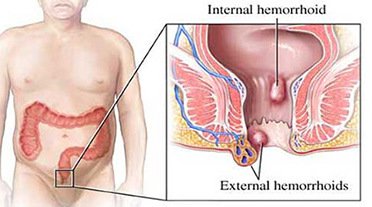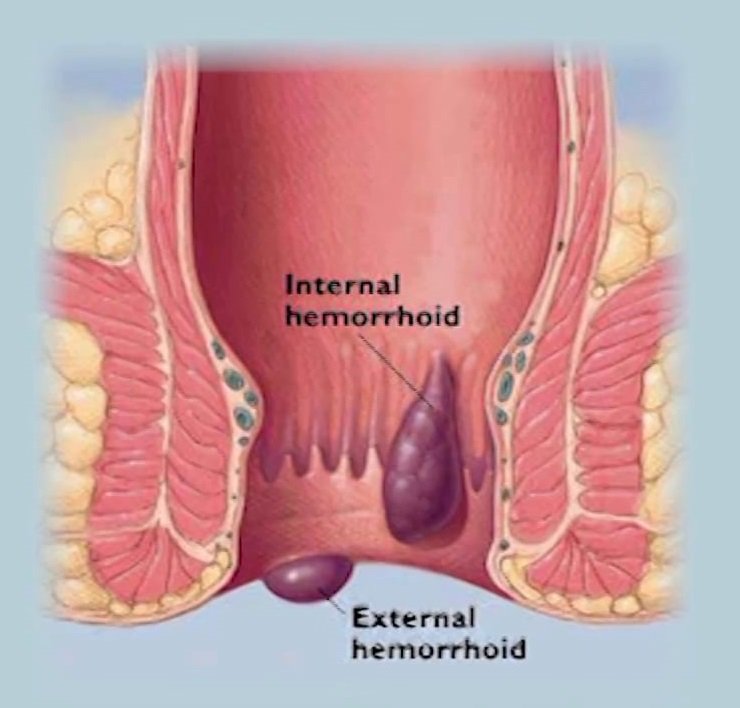Piles or Haemorrhoids Treatment in Pune
Piles or Haemorrhoids is enlargement or dilation of blood vessels in the rectal region. These blood vessels are called haemorrhoidal blood vessels. The word ‘Haemorrhoids’ is derived from the Greek word. Haima (bleed) + Rhoos (flowering), which means bleeding. The pile is derived from the Latin word ‘Pila’ meaning Ball.
If you suffering from Piles or a Haemorrhoids problem must consult a Qualified Laser Surgeon for Piles Treatment near you!!
Dr. Abhijit Gotkhinde is the Best Laser Surgeon for Piles in Pune.

Piles can be of three types:
Symptoms of Piles
The main symptom is painless “fresh red” bleeding during passing stools. Blood falls as drops or “splash in the pan” appearance. One may also feel a mass coming from the anus. Piles occur more commonly in young or middle-aged adults.
Other symptoms of Piles are as follows:
- Itchiness around the anus
- Blood in the stools
- Presence of pain during defecation – due to the associated fissure in ano.
- Presence of a hard lump around the anus
- Discharge of mucus while emptying the bowels
- Sore and red anus
- Sense of fullness in the anus; even after going to the toilet
- Generalized weakness due to anemia
What can happen if I ignore piles treatment?
- Many times patients feel embarrassed to seek medical treatment for piles. It is recommended to consult doctors when symptoms of piles are noted.
- The following complications may occur due to untreated piles:
- Infection
- Anal fistula
- Gangrene
- Incontinence in rare cases
- Anemia due to excessive blood loss.
Causes of Piles
- Straining
- Diarrhea
- Constipation
- Hard stool
- Low fiber diet
- Dehydration
- Vein damage
Risk factors with Piles
- Obesity
- Pregnancy
- Old age
- Associated diseases like cancer
- Diseases that make patients bed ridden like paralysis
Severity of Piles
The severity of Piles or haemorrhoids is given below.
- Grade I or First-degree haemorrhoids – these piles do not prolapse.
- Grade II or Second-degree haemorrhoids – these piles prolapse on straining.
- Grade III or Third-degree haemorrhoids – these piles prolapse on straining.
- Grade IV or Fourth-degree haemorrhoids – these types of piles get permanently prolapsed.
Diagnostics of Piles
Treatment of Piles
- Self-medication is not recommended. The main problem with medical management is the high recurrence rate. The more chronic the disease becomes, the poorer are the results of any further plan of treatment.
- Creams for piles can be easily purchased from any chemist. Most creams contain corticosteroids. Corticosteroid creams can be used for treating inflammation around the anus area. Since these creams contain steroids, prolonged use is not recommended as it can enhance the irritation.
- Using lubricating or anesthetizing gels can provide relief but only temporarily.
- Laxatives are recommended to get relief from constipation which is a root cause of piles most of the time. They help in the emptying of bowels. However, their continuous use can also invite lots of side effects.
- Many ayurvedic and other methods promise a complete cure, however, there is so scientific proof supporting such claims.
- The use of medical methods is limited to grade I or grade II piles.
- The process of banding involves tightening the piles or haemorrhoids with the help of elastic bands to cut off blood supply. It is expected that haemorrhoids fall off after this process within a week. It can be done as a day procedure. You can go to the office or do light work even on the next day.
- Banding procedure can only be done up to Grade II piles. It takes around 1-2 weeks for the piles to fall off. Only two piles can be treated at one time.
- Some pain and discomfort occurs which can be reduced with medicines.
- A chemical solution is injected into the blood vessels during this process. The size of piles gets reduced after about four to six weeks from this treatment. One can return back to routine activities soon after the treatment. As a standalone procedure its recurrence rates are high. The use of this method is limited up to Grade II piles.
- These days it is used as a supportive treatment along with more modern treatment methods like Minimal Invasive Piles and Haemorrhoids treatment (MIPH) or Laser haemorrhoidectomy.
- This method involves cutting a circular section of the anal lining canal above the piles with the aid of a circular stapling gun. It is a specialized instrument specially designed for the purpose of haemorrhoid treatment.
- This method helps in pulling the piles back up the anal canal. This process also reduces blood supply to the piles which result in their shrinkage. Since the cutting process takes place above the piles, it is less painful.
- Advantages:
- The recurrence rate is very less
- The most definitive treatment for piles as of today.
- Pain is very less
- Recovery is much faster
- Hospital admission time is 24 hrs or less.
- Can resume daily activities from the next day onwards
- No need for dressing and follow up
- Disadvantages
- Relatively more expensive.
- You need to undergo medical tests like any other surgery
- May have to take leave from work for one or two days.
- Are there any complications of Stapled hemorrhoidopexy
- Every surgery, irrespective of how minor, carries some risks and complications. However, with enough planning and precautions, we can reduce the chances to a minimum.
- Complications of Stapled hemorrhoidopexy :
- Narrowing of the anal canal after many years
- Excessive bleeding in case of severe piles
- The risk associated with anaesthesia
- What tests will I need to do before surgery?
- These will be prescribed and explained in detail during the time of consultation.
- But just to mention a few: Complete blood count (CBC), blood sugar, Kidney function test, Liver function test, X-ray, ECG, etc. These tests are for your own safety and benefit.
- Is there a guarantee of success for this procedure?
- We can take some precautions and follow instructions after surgery to prevent a recurrence. However, a hundred percent guaranteed success is a scam running quite commonly in the medical field. Please don’t fall for it.
Advantages
- Accuracy of tissue cutting is very high
- Minimal blood loss
- Minimal discomfort
- Early recovery
- Minimal hospital stay
- Can resume daily activities from next day
- No need for dressing and follow up.
Disadvantages
- The risk associated with anaesthesia
- Relatively more expensive.
- You need to undergo medical tests like any other surgery
- May have to take leave from work for one or two days.

Laser Surgery for Piles
This approach is used for the treatment of hemorrhoids under appropriate anesthesia. The fiber of the laser is inserted centrally into the hemorrhoidal node and energy is delivered. By this technique, hemorrhoids can be treated according to their size without causing any damage to the anoderm or mucosa.
Laser Haemorrhoidoplasty is the preferred treatment for Grade 2 and early stages of Grade 3 Piles. This procedure is done under short general anesthesia and takes about 20 minutes. Through the natural anal opening, laser energy is applied using a special radially emitting fiber. The controlled emission of laser energy causes vaporization leading the haemorrhoidal mass to shrink
Advantages of LHP
- No cuts, no open wounds
- Less post-operative pain as compared to other procedures
- Healing is excellent as there are no cuts or stitches
- No sense of urgency ( need to rush to the toilet ) after the procedure
- No risk of rectal stenosis
- Patient can return to normal activities within a shorter space of time

About Dr. Abhijit Gotkhinde – Laparoscopic & Laser Specialist Surgeon

Dr. Abhijit B. Gotkhinde
Consultant Laparoscopic & Laser Surgeon
MBBS, DNB (GEN SURGERY), FMAS,
FIAGES, Fellow in Adv lap.
Dr. Abhijit B. Gotkhinde is one of the Qualified basic & advanced Laparoscopic Surgeon and the best Laser Surgeons in the Hadapsar, Pune. He believes in delivering the most authentic and top-class services in Piles, Fissure, Fistula Treatments also Hernia Treatments like Epigastric Hernia, Umbilical hernias, Epigastric hernia, Inguinal hernia, Femoral Hernia.
He has extensive experience in GI & Colorectal surgeries. He has a special interest in Laparoscopic surgery (cholecystectomy, Appendectomy, Hernia, Hysterectomy & Hiatal surgery) and minimal access proctology surgery. (Piles, fissure & fistula).
There are various types of Hernia occurred in people. These hernias types include hiatus, incisional, and umbilical hernias. Symptoms are present in about 66% of people with Groin Hernias. So for that many treatments can be done for various Hernia Treatment within Laparoscopic Surgery Treatment. After trying various methods without complete information and knowledge many people fail to achieve the desired Laparoscopic Surgery or Laser Surgery for Hernia and Piles Treatment.
A well Qualified Professional in Laparoscopic Surgeon has the knowledge, expertise, and experience to treat patients who suffer from Hernia Treatments like Epigastric Hernia, Umbilical hernias, Epigastric hernia, Inguinal hernia, Femoral Hernia and Piles, Fissure, Fistula Treatments also.
Ultra Care Clinic is proud to say that we offer affordable quality care without any compromise, by a Qualified surgeon Dr. Abhijit Gotkhinde.
FAQ’s
- Bleeding per rectum(from the anus)
- Mucosal discharge(thick watery)
- Rectal fullness when piles are large
- Severe pain due to infection or thrombosis or necrosis
The diagnosis is based on history, physical examination, and endoscopy.
- Grade l: Internal hemorrhoid bulges into the anal canal during bowel movements(passing motions).
- Grade ll: Internal hemorrhoid bulges from the anus while passing stools, then goes back inside by itself.
- Grade lll: Internal hemorrhoid bulges from the anus during bowel movements and must be pushed back in with a finger(by patient/surgeon).
- Grade lV: Internal hemorrhoid protrudes from the anus all the time which can’t be reduced back into the anal canal
A. Medical management
1. High fiber diet(fruits, vegetables, etc)
2. Adequate hydration(proper intake of water)
3. Stool softener (in case of constipation)
4. To decrease the time spent on the toilet
B. surgical Management
Usual treatment options :
1. Change of diet and lifestyle (Grade I)
2. Lotions, medicaments, ointments (Grade I)
3. Rubberband, sclerotherapy, infrared coagulation (Grade I + II)
4. Closed surgery: Stapler Hemorrhoidopexy (Grade III)
5. Open surgery: Milligan-Morgan, Parks (Grade III + IV)
6. Hemorrhoid Laser Procedure(all grades).
1. Couple of days to a week in the hospital
2. Pain for 7-10 days
3. Postoperative bleeding
4. Infections
5. Abcess
6. Problems with sitting
7. Open wounds need 4-6 weeks to heel
8. Necessity of taking baths
- Minimally invasive laser therapy of hemorrhoids
- Controlled hemorrhoidal shrinkage
- Very good hemostasis
- Maximized preservation of continence
- Small wound sizesLaser HemorrhoidoPexy (LHP)
Also known as LaserHemorrhoidoPlasty
This approach is used for the treatment of hemorrhoids under appropriate anesthesia. The fiber of the laser is inserted centrally into the hemorrhoidal node and energy is delivered. By this technique, hemorrhoids can be treated according to their size without causing any damage to the anoderm or mucosa.
- If surgery is indicated, this therapy will provide you with an improved patient outcome especially regarding pain and recovery compared to conventional surgical proceeding for 2nd, 3rd, and 4th-degree hemorrhoids.
- Under proper local or general anesthesia, the controlled laser energy delivery obliterates the hemorrhoids from the inside and preserves the mucosa and sphincter structures to an extremely high degree(Tissue reduction in the hemorrhoids).
- The controlled emission of laser energy, which is applied submucosally, causes
the hemorrhoidal mass to shrink. - In addition, fibrotic reconstruction generates new connective tissue, which ensures that the mucosa adheres to the underlying
tissue. - This also prevents the occurrence or recurrence of prolapse. Laser hemorrhoidopexy is not associated with any risk of stenosis. Healing/result is excellent because, unlike conventional surgeries, there are no incisions/cut or stitches.
- Access to the hemorrhoid is achieved by entering through a small perianal port. By this approach, no wounds are generated in the area of the anoderm or mucosa. As a result, the patient experiences less post-operative pain and can return to normal activities within a shorter space of time.
1. No incisions
2. No excisions
3. No open woundsThree treatment principles with laser:
1. Reduction of the hemorrhoidal tissue, not total destruction/excision
2. Reconstruction of the natural anatomy
3. Nontouch of the anoderm
1. Diode Laser 980/1470nm
2. Laser Fiber: Delivery of energy in a conical shape
Characteristics of lasers fibers
1. Standard is bare fiber
2. Working mechanism: High temperatures on the fiber tip lead to a hot needle effect.
3. Temperature gradient to surrounding tissue structures.
- Painless procedure
- Outpatient or short hospital stay (overnight)
- Short downtimes
- No stenosis
- No incontinence
- No mucosa damaging
- No foreign body insertion (no clamp complications)
- Less complications
- Safe procedure
- Smaller wound
- Low complication rate
- Early Return to work
- High patient satisfaction
Patients and Methods
Between November 2010 and November 2016, 497 patients (age 55 ± 14 years) were submitted to laser haemorrhoidoplasty with a 1470 nm diode laser in the center for minimally invasive proctology in Siegen District Hospital. All operated patients were included in the study. Perioperative clinical and technical data up to 6 weeks and follow-up data up to 6 months were analyzed prospectively.
Results
The mean duration of operation was 14 min (± 5.2). A mean of 2.7 knots of 2.7 size was treated per patient. The mean postoperative pain was 2.5/10 (VAS). Long-term symptom relevance was 86%, and patient satisfaction 91%. Complications occurred in 49 patients (9.9%): bleeding 1.8%, infection 1%, urine retention 1.8%, oedema/thrombosis/prolapse 6.6%. 8.8% of patients suffered a relapse within 6 months. There were significant differences in pain on the day of the operation, and the parameters mucopexia, 3 treated segments, and energy level > 500 J (p < 0.05). Complications were more common when mucopexia was performed, with 3 treated knots and energy consumed per patient > 500 J. The only significant difference was for energy level > 500 J (p < 0.05).
Conclusion
LHP is a safe, low pain and minimally invasive surgical procedure with long-term good patient acceptance and satisfaction and is suited for routine work. The energy applied should be reduced to a minimum. Complication rates are largely comparable with those of other minimally invasive conventional methods. Additional prospective studies must be performed, particularly in comparison to the Parks method, which gives similar functional results. With circular confluent findings, LHP cannot replace stapler hemorrhoidopexia.
Watch Video
Testimonials
I met Dr. Gotkhinde for laparo chole surgery for gall stone. I want to treat it with medicine only. But with his knowledge of subject , crystal clear thinking and confidence I decided my mind and operated with him. In operation room I remember only one injection and when I woke up, surgery was over. Very little pain after surgery. Got discharge in 2 days.Thanks doctor.
After my difficult c section, I developed a hernia, I was really scared. My gyne sends me to Dr. Abhijit. It was a great decision to go with him. He done laparoscopy. My experience of surgery was exactly the same as what he told me before. He is a perfectionist surgeon.
Dr. Abhijit Gotkhinde sir operated my father for piles using a laser technique. Initially, we were quite anxious but after discussing with him about the procedure we felt confident. Surgery was done in less than 30 min & it was absolutely pain-free. He recovered in a single day. Within 1 week he is ready to work. Now we are thinking we would have done the procedure prior only. I must say, Dr. Gotkhinde is the best laser surgeon for piles.



